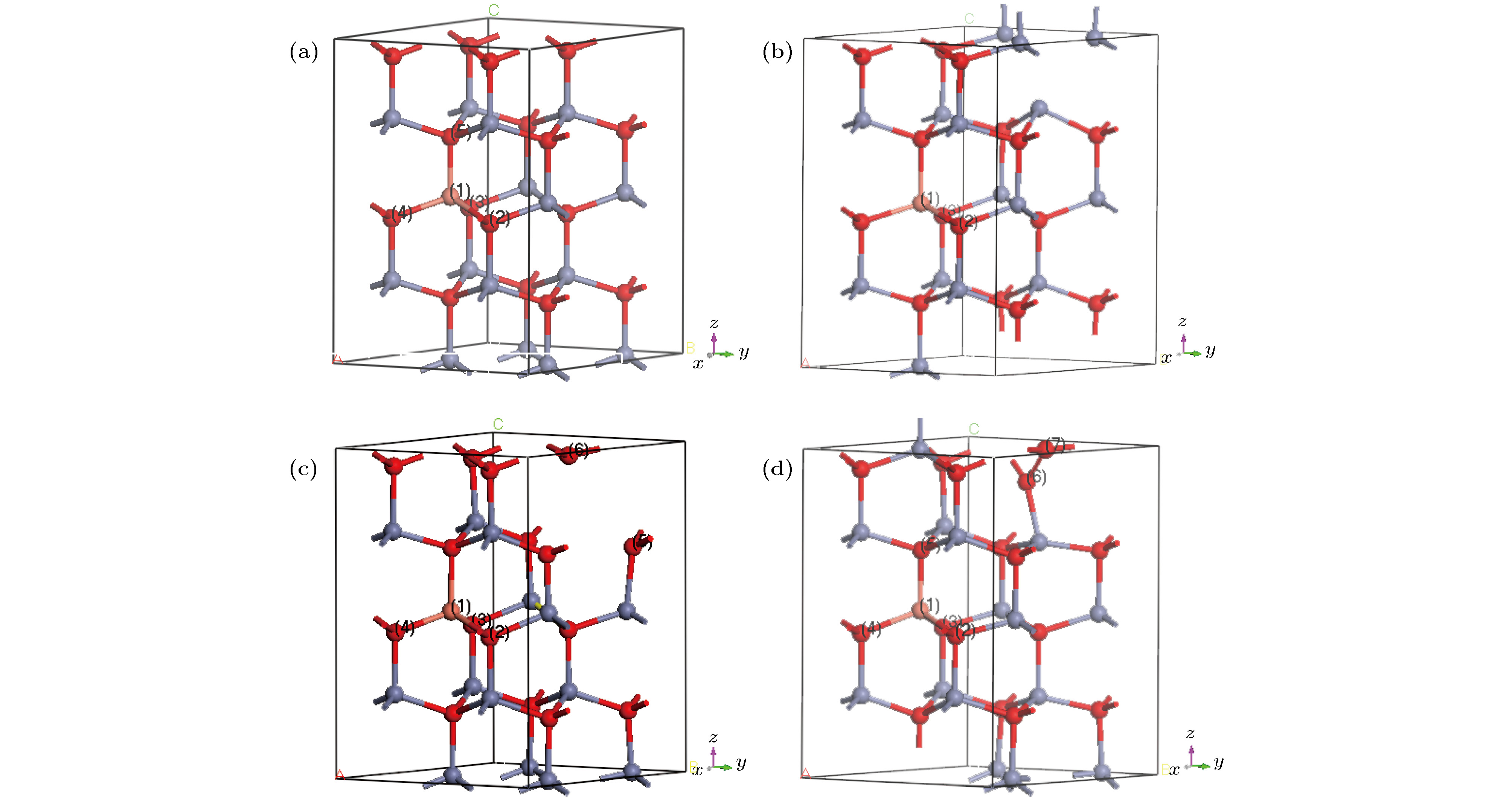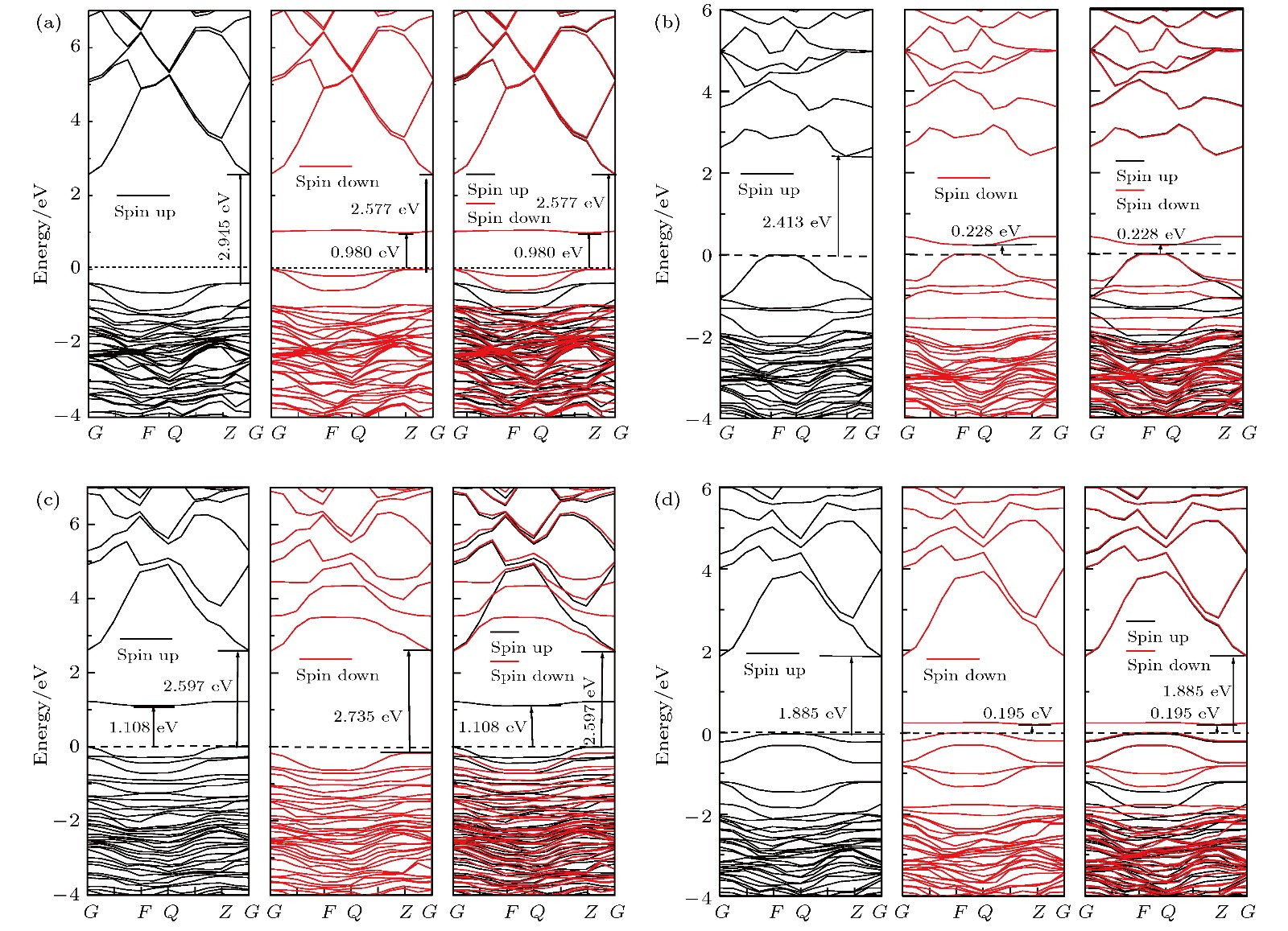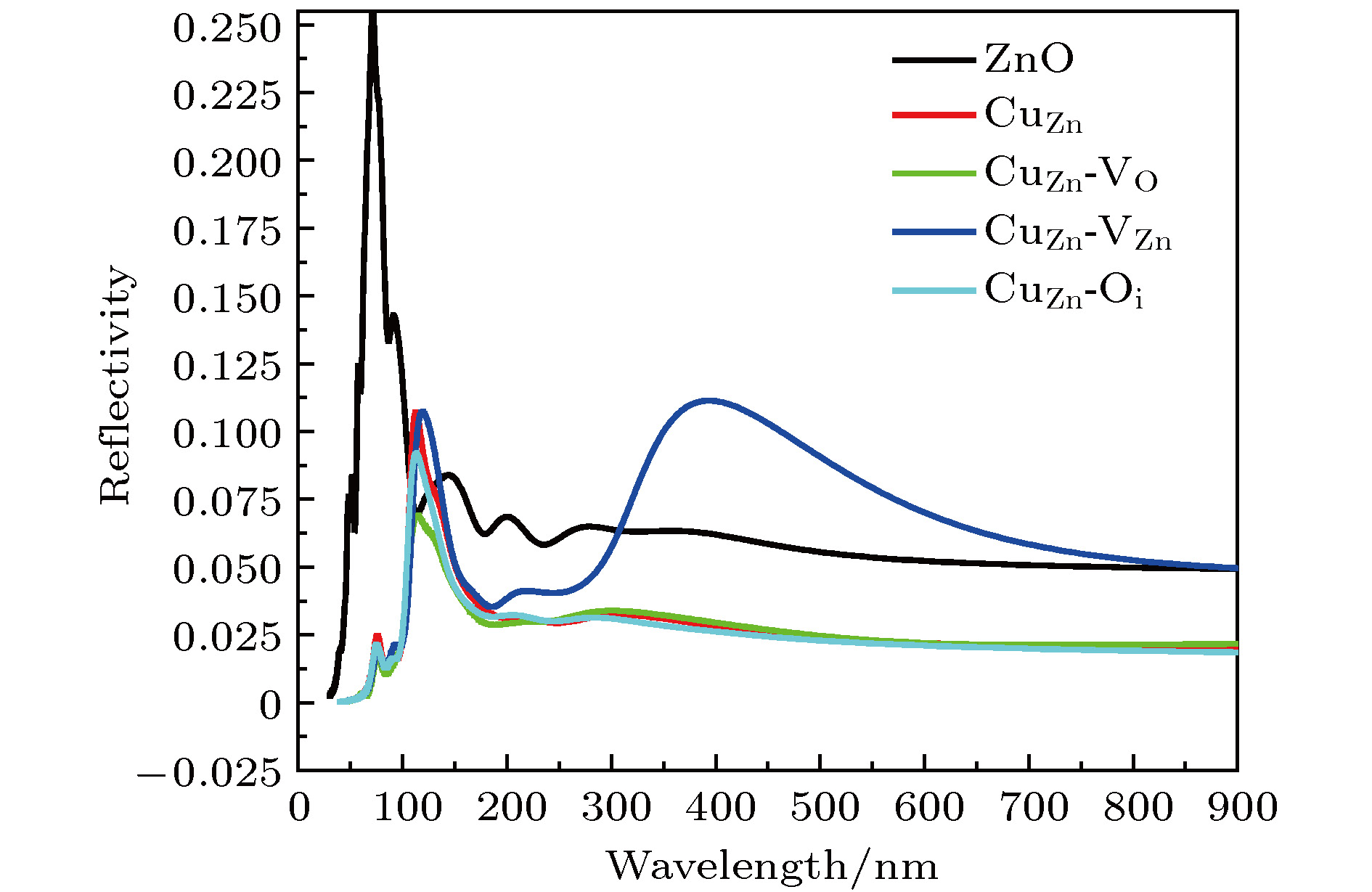-
For ZnO which is not magnetic itself, it is of great significance to study the source of ferromagnetism and its photoelectric properties when Cu doped ZnO coexists with internal defects. The effects of intrinsic defects on the electronic structures, magnetic and optical properties of Cu-doped ZnO (CuZn) are studied by using first principle calculations based on the density functional theory combined with the Hubbard U (DFT + Ud + Up). The results indicate that the doped Cu is a substitute acceptor, and the manufacturing environment plays an important role in forming the CuZn with internal defects. Under the oxygen-rich condition, the doped Cu is favorable for forming internal defects, and the CuZn—Oi bonds are easily formed. On the contrary, the Cu-doped ZnO is not conducive to forming internal defects under the O-poor condition. The 3d electrons of the substitute Cu form the unoccupied accepter energy level at the top of valence band, generating p-type conduction. Comparing with CuZn system, the carrier concentration of positive hole decreases in CuZn-VO system and the conductivity is poor. In the CuZn-VZn system, the number of carrier holes is almost constant, and the conductivity has no effect. In the CuZn-Oi model, the carrier concentration of positive holes increases and the conductivity gets better. The pure ZnO system exhibits non-magnetic behavior. The study also reveals that the smaller the electro-negativity, the greater the contribution to magnetic moment is when O atom is connected with Cu atom. The magnetic moments in CuZn and CuZn-Oi system are mainly generated by the coupling between the Cu 3d and the O 2p orbital on the c axis. When VO and VZn exist in CuZn, the magnetic moment is mainly caused by the strong coupling of Cu 3d with O 2p in ab plane. In the presence of VZn in CuZn, the magnetism also contains the contribution of the spin polarization of O(5, 6) atoms around VZn. In the defect states of CuZn-VZn and CuZn-Oi, the induced states in the deep energy levels are generated by the interaction between the O-O 2s orbital electrons. The reduced optical band gap of the CuZn model results in the red shift of absorption spectrum. The enhanced absorption and reflection of the CuZn-VZn model reduce the transmission.
-
Keywords:
- first principles /
- intrinsic defect /
- Cu-doped ZnO /
- formation energy
[1] Wang Z L 2008 ACS Nano 2 1987
 Google Scholar
Google Scholar
[2] Ahn K S, Deutsch T, Yan Y, Jiang C S, Perkins C L, Turner J, Jassim M A 2007 J. Appl. Phys. 102 023517
 Google Scholar
Google Scholar
[3] Wei M, Braddon N, Zhi D, Midgley P A, Chen S K, Blamire M G, Driscoll J L M 2005 Appl. Phys. Lett. 86 072514
 Google Scholar
Google Scholar
[4] Drmosh Q A, Rao S G, Yamani Z H, Gondal M A 2013 Appl. Surf. Sci. 270 104
 Google Scholar
Google Scholar
[5] Suja M, Bashar S B, Morshed M M, Liu J 2015 ACS Appl. Mater. Interfaces 7 8894
 Google Scholar
Google Scholar
[6] Chakraborty M, Ghosh A, Thangavel R 2015 J. Sol-Gel Sci. Technol. 74 756
 Google Scholar
Google Scholar
[7] Horzum S, Torun E, Serin T, Peeters F M 2016 Philos. Mag. 96 1743
 Google Scholar
Google Scholar
[8] Vachhani P S, Bhatnagar A K 2013 Phys. Scr. 8715 045702
[9] Xia C H, Wang F, Hu C L 2014 J. Alloys Compd. 589 604
 Google Scholar
Google Scholar
[10] 侯清玉, 许镇潮, 乌云, 赵二俊 2015 64 167201
 Google Scholar
Google Scholar
Hou Q Y, Xu Z C, Wu Y, Zhao E J 2015 Acta Phys. Sin. 64 167201
 Google Scholar
Google Scholar
[11] Iqbal J, Jan T, Shafiq M, Arshad A, Ahmad N, Badshah S, Yu R H 2014 Ceram. Int. 40 2091
 Google Scholar
Google Scholar
[12] Li T J, Li G P, Gao X X, Chen J S 2010 Chin. Phys. Lett. 27 211
[13] Nia B A, Shahrokhi M, Moradian R, Manouchehri I 2014 Eur. Phys. J. Appl. Phys. 67 20403
 Google Scholar
Google Scholar
[14] Keavney D J, Buchholz D B, Ma Q, Chang R P 2007 Appl. Phys. Lett. 91 012501
 Google Scholar
Google Scholar
[15] Xu Q Y, Schmidt H, Zhou S Q, Potzger K, Helm M, Hochmuth H, Lorenz M, Setzer A, Esquinazi P, Meinecke C, Grundmann M 2008 Appl. Phys. Lett. 92 082508
 Google Scholar
Google Scholar
[16] Zhu M Y, Zhang Z H, Zhong M, Tariq M, Li Y, Li W X, Jin H M, Skotnicova K, Li Y B 2017 Ceram. Int. 43 3166
 Google Scholar
Google Scholar
[17] Luo J H, Liu Q, Yang L N, Sun Z Z, Li Z S 2014 Comput. Mater. Sci. 82 70
 Google Scholar
Google Scholar
[18] Wang Q B, Zhou C, Wu J, Lü T 2013 Opt. Commun. 297 79
 Google Scholar
Google Scholar
[19] Chen Y F, Song Q G, Yan H Y 2012 Comput. Theor. Chem. 983 65
 Google Scholar
Google Scholar
[20] Lee M H, Peng Y C, Wu H C 2014 J. Alloys Compd. 616 122
 Google Scholar
Google Scholar
[21] Wu H C, Peng Y C, Chen C C 2013 Opt. Mater. 35 509
 Google Scholar
Google Scholar
[22] Segall M D, Lindan P J D, Probert M J, Pickard C J, Hasnip P J, Clark S J, Payne M C 2002 J. Phys.: Condens. Matter 14 2717
 Google Scholar
Google Scholar
[23] Perdew J P, Burke K, Ernzerhof M 1996 Phys. Rev. Lett. 77 3865
 Google Scholar
Google Scholar
[24] Ma X G, Lu B, Li D, Shi R, Pan C S, Zhu Y F 2011 J. Phys. Chem. C 115 4680
[25] Anisimov V V, Zaanen J, Andersen K 1991 Phys. Rev. B: Condens. Matter 44 943
 Google Scholar
Google Scholar
[26] Monkhost H J, Pack J D 1976 Phys. Rev. B 13 5188
 Google Scholar
Google Scholar
[27] Vanderbilt D 1990 Phys. Rev. B: Condens. Matter 41 7892
 Google Scholar
Google Scholar
[28] Janotti A, van de Walle C G 2007 Phys. Rev. B 76 165202
 Google Scholar
Google Scholar
[29] Guo T T, Dong G B, Chen Q, Diao X G, Gao F Y 2014 J. Phys. Chem. Solids 75 42
 Google Scholar
Google Scholar
[30] Sun H G, Fan W L, Li Y L, Cheng X F, Li P, Hao J C, Zhao X 2011 Phys. Chem. Chem. Phys. 13 1379
 Google Scholar
Google Scholar
[31] Chen Y, Xu X L, Zhang G H, Xue H, Ma S Y 2009 Physica B 404 3645
 Google Scholar
Google Scholar
[32] 段壮芬, 王新强, 何阿玲, 程志梅 2011 原子与分子 28 343
 Google Scholar
Google Scholar
Duan Z F, Wang X Q, He A L, Cheng Z M 2011 J. At. Mol. Phys. 28 343
 Google Scholar
Google Scholar
[33] Ferhat M, Zaoui A, Ahuja R 2009 Appl. Phys. Lett. 94 142502
 Google Scholar
Google Scholar
[34] Yan Y F, Aljassim M M, Wei S H 2006 Appl. Phys. Lett. 89 181912
 Google Scholar
Google Scholar
[35] Narendra G L, Sreedhar B, Rao J L, Lakshman S V J 1991 J. Mater. Sci. 26 5342
 Google Scholar
Google Scholar
[36] Lee H Y, Clark S J, Robertson J 2012 Phys. Rev. B 86 075209
 Google Scholar
Google Scholar
[37] 林俏露, 李公平, 许楠楠, 刘欢, 王苍龙 2017 66 037101
 Google Scholar
Google Scholar
Lin Q L, Li G P, Xu N N, Liu H, Wang C L 2017 Acta Phys. Sin. 66 037101
 Google Scholar
Google Scholar
[38] Zhao L, Lu P F, Yu Z Y, Liu Y M, Wang D L, Ye H 2010 Chin. Phys. B 19 056104
 Google Scholar
Google Scholar
[39] 徐庆岩, 吴雪梅, 诸葛兰剑, 陈学梅, 吴兆丰 2008 微细加工技术 12 16
Xu Q Y, Wu X M, Zhuge L J, Chen X M, Wu Z F 2008 MicroFabric. Tech. 12 16
-
表 1 ZnO和CuZn缺陷的形成能(单位: eV)
Table 1. Formation energy of ZnO and CuZn with intrinsic defects (in eV)
缺陷类型 VO VZn Oi Cui CuZn CuZn-VO CuZn-VZn CuZn-Oi O-rich 6.603 0.915 –0.548 5.795 –0.495 6.337 0.422 –0.965 O-poor 1.308 6.210 4.747 4.026 3.031 4.569 9.244 7.856 表 2 ZnO模型的带隙和空穴浓度P
Table 2. Band gap and hole concertration P of ZnO model
ZnO CuZn CuZn-VO CuZn-VZn CuZn-Oi 禁带宽度/eV 3.370 2.577 2.413 2.597 1.885 光学带隙/eV 3.370 0.980 0.228 1.108 0.195 P 0.068 1.344 1.107 1.321 1.574 -
[1] Wang Z L 2008 ACS Nano 2 1987
 Google Scholar
Google Scholar
[2] Ahn K S, Deutsch T, Yan Y, Jiang C S, Perkins C L, Turner J, Jassim M A 2007 J. Appl. Phys. 102 023517
 Google Scholar
Google Scholar
[3] Wei M, Braddon N, Zhi D, Midgley P A, Chen S K, Blamire M G, Driscoll J L M 2005 Appl. Phys. Lett. 86 072514
 Google Scholar
Google Scholar
[4] Drmosh Q A, Rao S G, Yamani Z H, Gondal M A 2013 Appl. Surf. Sci. 270 104
 Google Scholar
Google Scholar
[5] Suja M, Bashar S B, Morshed M M, Liu J 2015 ACS Appl. Mater. Interfaces 7 8894
 Google Scholar
Google Scholar
[6] Chakraborty M, Ghosh A, Thangavel R 2015 J. Sol-Gel Sci. Technol. 74 756
 Google Scholar
Google Scholar
[7] Horzum S, Torun E, Serin T, Peeters F M 2016 Philos. Mag. 96 1743
 Google Scholar
Google Scholar
[8] Vachhani P S, Bhatnagar A K 2013 Phys. Scr. 8715 045702
[9] Xia C H, Wang F, Hu C L 2014 J. Alloys Compd. 589 604
 Google Scholar
Google Scholar
[10] 侯清玉, 许镇潮, 乌云, 赵二俊 2015 64 167201
 Google Scholar
Google Scholar
Hou Q Y, Xu Z C, Wu Y, Zhao E J 2015 Acta Phys. Sin. 64 167201
 Google Scholar
Google Scholar
[11] Iqbal J, Jan T, Shafiq M, Arshad A, Ahmad N, Badshah S, Yu R H 2014 Ceram. Int. 40 2091
 Google Scholar
Google Scholar
[12] Li T J, Li G P, Gao X X, Chen J S 2010 Chin. Phys. Lett. 27 211
[13] Nia B A, Shahrokhi M, Moradian R, Manouchehri I 2014 Eur. Phys. J. Appl. Phys. 67 20403
 Google Scholar
Google Scholar
[14] Keavney D J, Buchholz D B, Ma Q, Chang R P 2007 Appl. Phys. Lett. 91 012501
 Google Scholar
Google Scholar
[15] Xu Q Y, Schmidt H, Zhou S Q, Potzger K, Helm M, Hochmuth H, Lorenz M, Setzer A, Esquinazi P, Meinecke C, Grundmann M 2008 Appl. Phys. Lett. 92 082508
 Google Scholar
Google Scholar
[16] Zhu M Y, Zhang Z H, Zhong M, Tariq M, Li Y, Li W X, Jin H M, Skotnicova K, Li Y B 2017 Ceram. Int. 43 3166
 Google Scholar
Google Scholar
[17] Luo J H, Liu Q, Yang L N, Sun Z Z, Li Z S 2014 Comput. Mater. Sci. 82 70
 Google Scholar
Google Scholar
[18] Wang Q B, Zhou C, Wu J, Lü T 2013 Opt. Commun. 297 79
 Google Scholar
Google Scholar
[19] Chen Y F, Song Q G, Yan H Y 2012 Comput. Theor. Chem. 983 65
 Google Scholar
Google Scholar
[20] Lee M H, Peng Y C, Wu H C 2014 J. Alloys Compd. 616 122
 Google Scholar
Google Scholar
[21] Wu H C, Peng Y C, Chen C C 2013 Opt. Mater. 35 509
 Google Scholar
Google Scholar
[22] Segall M D, Lindan P J D, Probert M J, Pickard C J, Hasnip P J, Clark S J, Payne M C 2002 J. Phys.: Condens. Matter 14 2717
 Google Scholar
Google Scholar
[23] Perdew J P, Burke K, Ernzerhof M 1996 Phys. Rev. Lett. 77 3865
 Google Scholar
Google Scholar
[24] Ma X G, Lu B, Li D, Shi R, Pan C S, Zhu Y F 2011 J. Phys. Chem. C 115 4680
[25] Anisimov V V, Zaanen J, Andersen K 1991 Phys. Rev. B: Condens. Matter 44 943
 Google Scholar
Google Scholar
[26] Monkhost H J, Pack J D 1976 Phys. Rev. B 13 5188
 Google Scholar
Google Scholar
[27] Vanderbilt D 1990 Phys. Rev. B: Condens. Matter 41 7892
 Google Scholar
Google Scholar
[28] Janotti A, van de Walle C G 2007 Phys. Rev. B 76 165202
 Google Scholar
Google Scholar
[29] Guo T T, Dong G B, Chen Q, Diao X G, Gao F Y 2014 J. Phys. Chem. Solids 75 42
 Google Scholar
Google Scholar
[30] Sun H G, Fan W L, Li Y L, Cheng X F, Li P, Hao J C, Zhao X 2011 Phys. Chem. Chem. Phys. 13 1379
 Google Scholar
Google Scholar
[31] Chen Y, Xu X L, Zhang G H, Xue H, Ma S Y 2009 Physica B 404 3645
 Google Scholar
Google Scholar
[32] 段壮芬, 王新强, 何阿玲, 程志梅 2011 原子与分子 28 343
 Google Scholar
Google Scholar
Duan Z F, Wang X Q, He A L, Cheng Z M 2011 J. At. Mol. Phys. 28 343
 Google Scholar
Google Scholar
[33] Ferhat M, Zaoui A, Ahuja R 2009 Appl. Phys. Lett. 94 142502
 Google Scholar
Google Scholar
[34] Yan Y F, Aljassim M M, Wei S H 2006 Appl. Phys. Lett. 89 181912
 Google Scholar
Google Scholar
[35] Narendra G L, Sreedhar B, Rao J L, Lakshman S V J 1991 J. Mater. Sci. 26 5342
 Google Scholar
Google Scholar
[36] Lee H Y, Clark S J, Robertson J 2012 Phys. Rev. B 86 075209
 Google Scholar
Google Scholar
[37] 林俏露, 李公平, 许楠楠, 刘欢, 王苍龙 2017 66 037101
 Google Scholar
Google Scholar
Lin Q L, Li G P, Xu N N, Liu H, Wang C L 2017 Acta Phys. Sin. 66 037101
 Google Scholar
Google Scholar
[38] Zhao L, Lu P F, Yu Z Y, Liu Y M, Wang D L, Ye H 2010 Chin. Phys. B 19 056104
 Google Scholar
Google Scholar
[39] 徐庆岩, 吴雪梅, 诸葛兰剑, 陈学梅, 吴兆丰 2008 微细加工技术 12 16
Xu Q Y, Wu X M, Zhuge L J, Chen X M, Wu Z F 2008 MicroFabric. Tech. 12 16
Catalog
Metrics
- Abstract views: 15532
- PDF Downloads: 171
- Cited By: 0















 DownLoad:
DownLoad:







